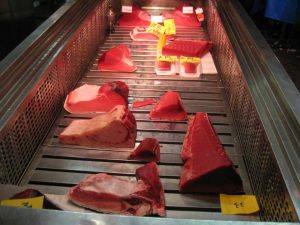
There are more and more people who have noticed that the tuna has returned to Danish waters.
No one really knows why, but it may have something to do with climate change. The temperature has risen slightly and, of course, it also affects the temperature in the sea.
There are lots of tuna in the world, not all types of tuna are suitable for sushi. Fish is divided into different grades so that the restaurants know what quality they have bought. Only the best quality tuna should be used for sushi.
Tuna are caught and end up in the international fish markets the quality of the tuna assessed by tuna experts, who divide the tuna into quality grades.
In Japan, many sushi restaurants visit their regular tuna supplier in the early morning hours. The tuna is then sold to sushi restaurants and classic restaurants, which usually use the tuna on the same day.
On the Sushi course for beginners, the best quality tuna is used and it is caught in the east.
_
Zoë has lectured and held sushi courses for A. P. Moller – Maersk, Hugo Boss Nordic, Novo Nordisk, Novartis, Velux, Gorrissen Federspiel, Beierholm revision, Elbek & Vejrup and many more.







